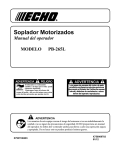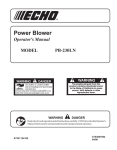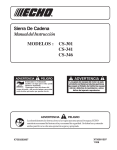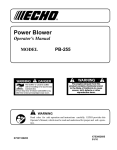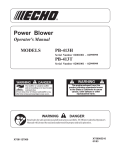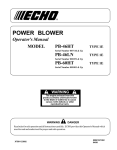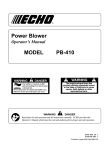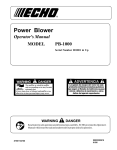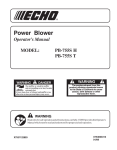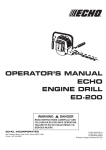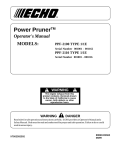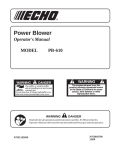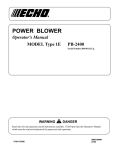Download Echo PB-265L User's Manual
Transcript
Power Blower Operator's Manual MODEL PB-265L WARNING Read rules for safe operation and instructions carefully. ECHO provides this Operator's Manual, which must be read and understood for proper and safe operation. X7531180400 X753002580 10/06 2 INTRODUCTION Welcome to the ECHO family. This ECHO product was designed and manufactured to provide long life and on-the-jobdependability. Read and understand this manual. You will find it easy to use and full of helpful operating tips and SAFETY messages. THE OPERATOR'S MANUAL Read and understand this manual before operation. Keep it in a safe place for future reference. It contains specifications and information for operation, starting, stopping, maintenance, storage, and assembly specific to this product. TABLE OF CONTENTS Introduction .................................................................. 2 - The Operator's Manual .......................................... 2 Safety ............................................................................ 3 - Manual Safety Symbols and Important Information3 - International Symbols ............................................ 3 - Personal Condition and Safety Equipment ............ 3 - Equipment .............................................................. 6 Emission Control ........................................................... 6 Description ................................................................... 7 Contents ....................................................................... 9 Assembly ..................................................................... 10 - Install Blower Pipes .............................................. 10 Operation ..................................................................... 11 - Fuel .......................................................................11 - Starting Cold Engine ............................................. 12 - Starting Warm Engine ...........................................13 - Stopping Engine ................................................... 13 - Operating Blower ..................................................14 Copyright© 2006 By Echo, Incorporated All Rights Reserved. Maintenance ................................................................ 15 - Skill Levels ............................................................15 - Maintenance Intervals ..........................................15 - Air Filter ................................................................ 16 - Fuel Filter ..............................................................16 - Spark Plug .............................................................17 - Cooling System ..................................................... 17 - Exhaust System ..................................................... 18 - Carburetor Adjustment ......................................... 19 Troubleshooting .......................................................... 20 Storage .........................................................................21 Specifications ............................................................... 22 Servicing Information ................................................... 24 - Parts/Serial Number .............................................. 24 - Service ..................................................................24 - ECHO Consumer Product Support ........................24 - Warranty Card ......................................................24 - Additional or Replacement Manuals ....................24 Specifications, descriptions and illustrative material in this literature are as accurate as known at the time of publication, but are subject to change without notice. Illustrations may include optional equipment and accessories, and may not include all standard equipment. POWER BLOWER OPERATOR'S MANUAL SAFETY MANUAL SAFETY SYMBOLS AND IMPORTANT INFORMATION Throughout this manual and on the product itself, you will find safety alerts and helpful, informational messages preceded by symbols or key words. The following is an explanation of those symbols and key words. CIRCLE AND SLASH SYMBOL DANGER The safety alert symbol accompanied by the word “DANGER” calls attention to an act or condition which WILL lead to serious personal injury or death if not avoided. WARNING The safety alert symbol accompanied by the word “WARNING” calls attention to an act or condition which CAN lead to serious personal injury or death if not avoided. CAUTION This symbol means the specific action shown is prohibited. Ignoring these prohibitions can result in serious or fatal injury. NOTE This enclosed message provides tips for use, care and maintenance of the unit. IMPORTANT The enclosed message provides information necessary for the protection of the unit. The safety alert symbol accompanied by the word “CAUTION” calls attention to an act or condition which may lead to minor or moderate personal injury if not avoided. INTERNATIONAL SYMBOLS Symbol form/shape Symbol description/application Symbol form/shape Symbol description/application Symbol form/shape Symbol description/application Read and understand Operator's Manual. Fuel and oil mixture Emergency stop Wear eyes, ears and head protection Finger Severing Carburetor adjustment - Low speed mixture Hot Surface Safety/Alert DO NOT allow flames or sparks near fuel. Wear hand protection. Use two handed. Wear slip resistant foot wear. DO NOT smoke near fuel. Symbol form/shape Symbol description/application Ignition ON/OFF Primer bulb Carburetor adjustment - Idle speed Carburetor adjustment - High speed mixture Choke Control "Cold Start" Position (Choke Closed) Choke Control "Run" Position (Choke Open) Idle Speed Fast Speed PERSONAL CONDITION AND SAFETY EQUIPMENT WARNING Power Blower users risk injury to themselves and others if the power blower is used improperly or safety precautions are not followed. Proper clothing and safety gear must be worn when operating a blower. 3 4 Physical Condition Your judgment and physical dexterity may not be good: • if you are tired or sick, • if you are taking medication, • if you have taken alcohol or drugs. Operate unit only if you are physically and mentally well. Eye Protection Wear eye protection that meets ANSI Z87.1 or CE requirements whenever you operate the unit. Hand Protection Wear no-slip, heavy-duty work gloves to improve your grip on the blower handle. Gloves also reduce the transmission of machine vibration to your hands. Breathing Protection Wear a facemask to protect against dust. Hearing Protection ECHO recommends wearing hearing protection whenever unit is used. Proper Clothing Wear snug fitting, durable clothing; • Pants should have long legs, shirts with long sleeves. • DO NOT WEAR SHORTS, • DO NOT WEAR TIES, SCARVES, and JEWELRY. Wear sturdy work shoes with nonskid soles: • DO NOT WEAR OPEN TOED SHOES, • DO NOT OPERATE UNIT BAREFOOTED. Keep long hair away from engine and blower intake. Retain hair with cap or net. Hot Humid Weather Heavy protective clothing can increase operator fatigue, which may lead to heat stroke. Schedule heavy work for early morning or late afternoon hours when temperatures are cooler. Vibration and Cold It is believed that a condition called Raynaud’s Phenomenon, which affects the fingers of certain individuals, may be brought about by exposure to vibration and cold. Exposure to vibration and cold may cause tingling and burning sensations, followed by loss of color and numbness in the fingers. The following precautions are strongly recommended, because the minimum exposure, which might trigger the ailment, is unknown. • Keep your body warm, especially the head, neck, feet, ankles, hands, and wrists. • Maintain good blood circulation by performing vigorous arm exercises during frequent work breaks, and also by not smoking. • Limit the hours of operation. Try to fill each day with jobs where operating the unit or other hand-held power equipment is not required. • If you experience discomfort, redness, and swelling of the fingers followed by whitening and loss of feeling, consult your physician before further exposing yourself to cold and vibration. POWER BLOWER OPERATOR'S MANUAL Repetitive Stress Injuries It is believed that overusing the muscles and tendons of the fingers, hands, arms, and shoulders may cause soreness, swelling, numbness, weakness, and extreme pain in those areas. Certain repetitive hand activities may put you at a high risk for developing a Repetitive Stress Injury (RSI). An extreme RSI condition is Carpal Tunnel Syndrome (CTS), which could occur when your wrist swells and squeezes a vital nerve that runs through the area. Some believe that prolonged exposure to vibration may contribute to CTS. CTS can cause severe pain for months or even years. To reduce the risk of RSI/CTS, do the following: • Avoid using your wrist in a bent, extended, or twisted position. Instead, try to maintain a straight wrist position. Also, when grasping, use your whole hand, not just the thumb and index finger. • Take periodic breaks to minimize repetition and rest your hands. • Reduce the speed and force with which you do the repetitive movement. • Do exercises to strengthen the hand and arm muscles. • Immediately stop using all power equipment and consult a doctor if you feel tingling, numbness, or pain in the fingers, hands, wrists, or arms. The sooner RSI/CTS is diagnosed, the more likely permanent nerve and muscle damage can be prevented. DANGER Do not operate this product indoors or in inadequately ventilated areas. Engine exhaust contains poisonous emissions and can cause serious injury or death. Read the Manuals • Provide all users of this equipment with the Operator’s Manual and Safety Manual for instructions on Safe Operation. Clear the Work Area • Spectators and fellow workers must be warned, and children and animals prevented from coming nearer than 15 m (50 ft.) while the unit is in use. • Take wind conditions into account: avoid open doors and windows. • Do not point blower at people or animals. Keep a Firm Grip • Hold the stick handle with thumb and fingers encircling the handle. Keep a Solid Stance • Maintain footing and balance at all times. Do not stand on slippery, uneven, or unstable surfaces. Do not work in odd positions or on ladders. Do not over reach. Avoid Hot Surfaces • Keep exhaust area clear of flammable debris. Avoid contact during and immediately after operation. 5 6 EQUIPMENT CHECK WARNING Use only ECHO approved attachments. Serious injury may result from the use of a non-approved attachment combination. ECHO, INC. will not be responsible for the failure of cutting devices, attachments or accessories which have not been tested and approved by ECHO. Read and comply with all safety instructions listed in this manual and safety manual. • Check unit for loose/missing nuts, bolts and screws. Tighten and/or replace as needed. • Inspect fuel lines, tank and area around carburetor for fuel leaks. DO NOT operate unit if leaks are found. • Do not use blower if any part is missing or damaged. • Have repairs done only by an authorized ECHO Service dealer. • Do not use any attachment, accessory or replacement part unless it is recommended in this Operator's Manual. EMISSION CONTROL EPA Phase 2 The emission control system for these engines are EM/TWC (Engine and Catalyst Modification). IMPORTANT ENGINE INFORMATION ENGINE FAMILY: 6EHXS.0254KF DISPLACEMENT: EMISSION COMPLIANCE PERIOD : 300 HRS. 25.4 CC THIS ENGINE MEETS U.S. EPA PH2 AND 2005 - 2006 CALIFORNIA EMISSION REGULATIONS FOR SOREs. REFER TO OWNER'S MANUAL FOR MAINTENANCE SPECIFICATIONS AND ADJUSTMENTS. An Emission Control Label is located on the unit. (This is an EXAMPLE ONLY, information on label varies by engine FAMILY). PRODUCT EMISSION DURABILITY The 300 hour emission durability compliance period is the time span selected by the manufacturer certifying the engine emissions output meets applicable emissions regulations, provided that approved maintenance procedures are followed as listed in the Maintenance Section of this manual. POWER BLOWER OPERATOR'S MANUAL DESCRIPTION Locate the safety decals on your unit. Make sure the decals are legible and that you understand and follow the instructions on them. If a decal cannot be read, a new one can be ordered from your ECHO dealer. See PARTS ORDERING instructions for specific information. 3 4 13 2 5 1 14 12 11 6 10 7 9 8 15 18 17 1 16 Hot Decal (near muffler and engine) P/N 89016006361 Sound Label (located on blower housing) P/N X508000120 65 dB(A) 2 Category I Measured at 50 ft. (15m) per ANSI B175.2 3 General Warning Decal (located on blower housing) P/N 89016009461 7 8 1. SAFETY DECAL - Lists important safety precautions. 2. SAFETY DECAL - Lists important safety precautions. 3. SAFETY DECAL - Lists important safety precautions. 4. SPARK PLUG - Provides spark to ignite fuel mixture. 5. SPARK ARRESTOR - CATALYTIC MUFFLER / MUFFLER -The muffler or catalytic muffler controls exhaust noise and emission. The spark arrestor screen prevents hot, glowing particles of carbon from leaving the muffler. Keep exhaust area clear of flammable debris. 6. SERIAL NUMBER LABEL - Lists model number and serial number of unit. 7. RECOIL STARTER HANDLE - Pull recoil handle slowly until starter engages, then quickly and firmly. When engine starts, return handle slowly. DO NOT let handle snap back or damage to unit will occur. 8. FUEL TANK CAP - Covers and seals fuel tank. 9. FUEL TANK - Contains fuel and fuel filter. 10. AIR CLEANER - Contains replaceable air filter element. 11. HANDLE - Rotates downward for throttle control access. Spring loaded for flexible operation. 12. THROTTLE POSITION LEVER/STOP SWITCH - Combination stop switch and variable speed throttle lever. When the lever is moved all the way forward the blower is at Wide Open Throttle (W.O.T.). When the lever is moved rearward to detent, the blower is at idle. When the lever is moved rearward past the idle detent the blower will stop. 13. CHOKE - Choke is located on the side of the air cleaner. Move choke lever to "COLD START" ( for cold starting. Move choke lever to "RUN" ( ) to close choke ) position to open choke. 14. PURGE BULB - Pumping purge bulb before starting engine draws fresh fuel from the fuel tank, purging air from the carburetor. Pump purge bulb until fuel is visible and flows freely in the clear fuel tank return line. Pump purge bulb an additional 4 or 5 times. 15. SHOULDER HARNESS - Used to support unit on operator's back. The straps are adjustable. 16. BLOWER PIPES - Exclusive positive locking system. 17. FLEXIBLE PIPE - Allows for full range of movement. 18. STICK HANDLE - Used by operator to direct air flow. POWER BLOWER OPERATOR'S MANUAL CONTENTS __ 1 __ 1 __ 1 __ 1 __ 1 __ 1 __ 1 __ 1 __ 1 __ __ __ 1 - Power Head - Flex Pipe - Swivel Pipe - Straight Pipe - Straight Pipe w/decal - Operator's Manual - Warranty Registration Card - ECHO Emissions and Warranty Statement - Plastic Bag 2 - Clamps w/screws 1 - Stick Handle Assembly - Echo Power Blend TM 2-stroke oil sample 9 10 ASSEMBLY WARNING Never perform maintenance or assembly procedures with engine running or serious personal injury may result. INSTALL BLOWER PIPES / STICK HANDLE 1. Assemble clamps (A) onto both ends of flexible pipe (B). 2. Assemble swivel pipe (C) into flexible pipe (B) and tighten clamp (A). 3. Assemble flexible pipe (B) to elbow (D) on blower and tighten clamp (A). D NOTE A light lubricant may be used to ease assembly of flexible pipe to blower elbow. B C A H 4. Loosen wing nut (E) completely and open stick handle clamp. 5. Align notches (F) in handle clamp with tabs (G). 6. Slide stick handle onto swivel pipe (C). Stick handle should be angled away from operator. H 7. Position stick handle (H) for comfortable operation, and tighten wing nut (E). 8. Assemble straight pipe (I) onto swivel pipe (C), until you feel light resistance. Do not force connection. Hold swivel pipe and turn straight pipe counter clockwise, engaging positive locking channels,until connection is firm. Do not force connention. 9. F G E B Assemble straight pipe with decal (J) to straight pipe (I) as in step 8. NOTE Blower use will eventually loosen pipe connections. Exclusive positive locking system allows pipes to be tightened. If loosening occurs, remove two straight pipes and install according to instructions 8 & 9. I C J POWER BLOWER OPERATOR'S MANUAL 11 OPERATION NOTE: Use of unmixed, improperly mixed, or fuel older than 90 days, (stale fuel), may cause hard starting, poor performance, or severe engine damage and void the product warranty. Read and follow instructions in the Storage section of this manual. FUEL Fuel Requirements Gasoline - Use 89 Octane [R+M/2] (mid grade or higher) gasoline known to be good quality. Gasoline may contain up to 15% MTBE (methyl tertiary-butyl ether). Gasohol containing methyl (wood) alcohol is NOT approved. Two Stroke Oil - A two-stroke engine oil meeting ISO-L-EGD (ISO/CD 13738) and J.A.S.O. FC Standards must be used. Echo brand premium Power Blend TM Universal 2-Stroke Oil meets these standards. Engine problems due to inadequate lubrication caused by failure to use an ISO-L-EGD and J.A.S.O. FC certified oil, such as Echo premium Power Blend TM, will void the two-stroke engine warranty. (Emission related parts only are covered for two years, regardless of two-stroke oil used, per the statement listed in the Emission Defect Warranty Explanation.) IMPORTANT Echo premium Power Blend TM Universal 2-Stroke Oil may be mixed at 50:1 ratio for application in all Echo engines sold in the past regardless of ratio specified in those manuals. Handling Fuel DANGER Fuel is VERY flammable. Use extreme care when mixing, storing or handling or serious personal injury may result. • Use an approved fuel container. • DO NOT smoke near fuel. • DO NOT allow flames or sparks near fuel. • Fuel tanks/cans may be under pressure. Always loosen fuel caps slowly allowing pressure to equalize. • NEVER refuel a unit when the engine is HOT or RUNNING! • DO NOT fill fuel tanks indoors. ALWAYS fill fuel tanks outdoors over bare ground. • DO NOT overfill fuel tank. Wipe up spills immediately. • Securely tighten fuel tank cap and close fuel container after refueling. • Inspect for fuel leakage. If fuel leakage is found, do not start or operate unit until leakage is repaired. • Move at least 3m (10 ft.) from refueling location before starting the engine. Fuel to Oil Mix - 50: 1 Ratio U.S. METRIC GAS OIL GAS OIL Gallons Fl. oz. Liter cc. 1 2 5 2.6 5.2 13 4 8 20 80 160 400 Mixing Instructions 1. Fill an approved fuel container with half of the required amount of gasoline. 2. Add the proper amount of 2-stroke oil to gasoline. 3. Close container and shake to mix oil with gasoline. 4. Add remaining gasoline, close fuel container, and remix. IMPORTANT Spilled fuel is a leading cause of hydrocarbon emissions. Some states may require the use of automatic fuel shut-off containers to reduce fuel spillage. After use • DO NOT store a unit with fuel in its tank. Leaks can occur. Return unused fuel to an approved fuel storage container. Storage - Fuel storage laws vary by locality. Contact your local government for the laws affecting your area. As a precaution, store fuel in an approved, airtight container. Store in a well-ventilated, unoccupied building, away from sparks and flames. IMPORTANT Stored fuel ages. Do not mix more fuel than you expect to use in thirty (30) days, ninety (90) days when a fuel stabilizer is added. IMPORTANT Stored two-stroke fuel may separate. ALWAYS shake fuel container thoroughly before each use. 12 STARTING COLD ENGINE • Recoil starter: Use short pulls - only 1/2-2/3 of rope length for starting. Do not allow the rope to snap back in. Always hold the unit firmly. • Rotate throttle handle downward to a comfortable operating position. 1. Throttle Position Lever Move throttle position lever (A) to START/IDLE DETENT position( 2. ). Choke Move choke (B) to "Cold Start" ( ) position. 3. Purge Bulb Pump purge bulb (C) until fuel is visible and flows freely in the clear fuel tank return line. 4. Recoil Starter Pull recoil starter handle (D) until engine fires, or maximum 5 pulls. 5. A B C Choke Move choke (B) to run ( engine. ) position and if necessary, restart NOTE If engine does not start after 5 pulls, repeat instructions 2-5. NOTE Allow engine to warm up before use. D POWER BLOWER OPERATOR'S MANUAL STARTING WARM ENGINE A The starting procedure is the same as Cold Start except DO NOT close the choke. 1. Throttle Position Lever Move throttle position lever (A) to start/idle detent position( ). 2. Purge Bulb Pump purge bulb (C) until fuel is visible and flows freely in the clear fuel tank return line. 3. Recoil Starter Pull recoil starter handle (D) and engine should start. C D NOTE If engine does not start after 5 pulls, use cold start procedures. STOPPING ENGINE 1. 2. Throttle Position Lever Move throttle position lever (A) to idle detent position( allow engine to return to idle before shutting off engine. Move throttle lever (A) to " " (Stop) position. WARNING If engine does not stop when throttle lever is moved to STOP position, close choke - COLD START position - to stall engine. Have your ECHO dealer repair stop switch before using blower again. ) and A 13 14 OPERATING BLOWER WARNING Always wear safety glasses, hearing protection, face filter mask and take all safety precautions or serious personal injury may result. Do not point the blower pipe in the direction of people or pets. Read the Safety Section carefully. IMPORTANT To avoid engine damage due to over revving, do not block blower pipe opening. 1. Use only during appropriate hours. 2. Allow the engine to warm up at a fast idle for a few minutes. 3. Set engine speed with throttle position lever (A). 4. Use lower speed to blow dry grass and leaves from walks, patios and drives. 5. Additional speed may be necessary to clean leaves from a lawn or flower bed. 6. Higher speed may be necessary to move gravel, dirt, snow, bottles or cans from a driveway, street, parking lot or stadium. NOTE Never use a higher speed setting than necessary to perform a task. Remember, the higher the engine speed, the louder the blower noise. Minimize dust by using blower at lower speeds and by dampening material with water/mist when necessary. Keep debris on your property. Be Smart - be a good neighbor. A POWER BLOWER OPERATOR'S MANUAL 15 MAINTENANCE Your ECHO blower is designed to provide many hours of trouble free service. Regular scheduled maintenance will help your blower achieve that goal. If you are unsure or are not equipped with the necessary tools, you may want to take your unit to an ECHO Service Dealer for maintenance. To help you decide whether you want to DO-IT-YOURSELF or have the ECHO Dealer do it, each maintenance task has been graded. If task is not listed, see your ECHO Dealer for repairs. SKILL LEVELS Level 1 = Level 2 = Level 3 = Easy to do. Most required tools come with unit. Moderate difficulty. Some specialized tools may be required. Experience required. Specialized tools are required. Echo recommends that the unit be returned to your ECHO dealer for service. ECHO offers REPOWERTM Maintenance Kits and Parts to make your maintenance job easier. Just below each task heading are listed the various part numbers required for that task. See your ECHO dealer for these parts. MAINTENANCE INTERVALS COMPONENT/ SYSTEM MAINTENANCE PROCEDURE REQ'D SKILL LE V E L DAILY OR BEFORE U SE EVERY R E FU E L 3 MONTHS OR 90 HOURS 6 MONTHS OR 270 HOURS YEARLY Recommended Echo Dealer Maintenance Procedures Cylinder Exhaust Port Inspect/Clean/Decarbon 3 I/C Do-It-Yourself Maintenance Procedures Air Filter Inspect/Clean/Replace 1 I/C Choke Inspect/Clean 2 I/C Fuel Filter Inspect/Replace 1 Fuel System, Leaks Inspect/Replace 1 I Cooling System Inspect/Clean 2 I/C Muffler Spark Arrestor Inspect/Replace 2 Recoil Starter Rope Inspect/Clean 1 Spark Plug Inspect/Clean 2 Screws/Nuts/Bolts Inspect/Tighten/Replace 1 R* R* I I / R* I / R* I/C I / R* I/C R* I / R* MAINTENANCE PROCEDURE LETTER CODES: I = INSPECT, R = REPLACE, C = CLEAN IMPORTANT NOTE - Time intervals shown are maximum. Actual use and your experience will determine the frequency of required maintenance. MAINTENANCE PROCEDURE NOTES: * All recommendations to replace are based on the finding of damage or wear during inspection. 16 AIR FILTER Level 1. Tools required: 25-50 mm (1-2 in.) Cleaning brush Parts required: Air filter 1. Close choke (Cold Start Position [ ]). This prevents dirt from entering the carburetor throat when the air filter is removed. Brush accumulated dirt from air cleaner area. 2. Remove air filter cover. Brush dirt from inside cover. 3. Remove air filter and lightly brush debris from filter. Replace filter if it is damaged, fuel soaked, very dirty, or the rubber sealing edges are deformed. 4. If filter can be reused, be certain it: • Fits tightly in the air filter cavity. • Is installed with the original side out. 5. Install air filter cover. FUEL FILTER Level 1. Tools required: 200-250 mm (8-10 in.) length of wire with one end bent into a hook, clean rag, funnel, and an approved fuel container Parts required: Fuel line and filter DANGER Fuel is VERY flammable. Use extreme care when mixing, storing or handling. 1. Use a clean rag to remove loose dirt from around fuel cap and empty fuel tank. 2. Use the “fuel line hook” to pull the fuel line and filter from the tank. 3. Remove the filter from the line and install the new filter. POWER BLOWER OPERATOR'S MANUAL SPARK PLUG Level 2. Tools required: T-Wrench, Feeler gauge Parts Required: Spark plug IMPORTANT Use only NGK BPM8Y spark plug otherwise severe engine damage may occur. 1. Remove spark plug and check for fouling, worn and rounded center electrode. 2. Clean the plug or replace with a new one. DO NOT sand blast to clean. Remaining sand will damage engine. 3. Adjust spark plug gap by bending outer electrode. 4. Tighten spark plug to 150-170 kg/cm (130-150 in. lb.). 0.65 mm (0.026 in.) COOLING SYSTEM Level 2. Tools required: 4mm x 130 mm (5") long hex wrench, cleaning brush Parts Required: None, if you are careful. IMPORTANT To maintain proper engine operating temperatures, cooling air must pass freely through the cylinder fin area. This flow of air carries combustion heat away from the engine. Overheating and engine seizure can occur when: • Air intakes are blocked, preventing cooling air from reaching the cylinder. • Dust and grass build up on the outside of the cylinder. This build up insulates the engine and prevents the heat from leaving. Removal of cooling passage blockages or cleaning of cooling fins is considered “Normal Maintenance.” Any failure attributed to lack of maintenance is not warranted. Cleaning Grill and Cylinder Fins 1. Remove accumulated debris from intake grill between backpack frame and blower housing. 2. Disconnect spark plug lead from spark plug. INTAKE GRILL 17 18 3. Remove spark plug 4. Remove engine cover - 7 screws. 5. Loosely install spark plug to keep dirt out of cylinder. 6. Clean cylinder fins to allow cooling air to pass freely. 7. Reassemble parts in reverse order. IMPORTANT Do not over-tighten screws, otherwise mounting holes may become stripped. EXHAUST SYSTEM Spark Arrestor Screen Level 2. Tools required: Cross Head Screwdriver, 4 mm Hex Wrench, Soft metal brush Parts Required: Spark arrestor screen, Gasket IMPORTANT Carbon deposits in muffler will cause a drop in engine output and overheating. Spark arrestor screen must be checked periodically. 1. Disconnect spark plug lead from spark plug. 2. Remove engine cover - 7 screws. 3. Remove exhaust deflector (A), spark arrestor cover (B), gasket (C), and spark arrestor screen (D) from muffler. Replace screen if plugged with carbon deposits. D C B NOTE When cleaning carbon deposits, be careful not to damage the catalytic element inside muffler. 4. Install spark arrestor screen, gaskets, and covers. 5. Install engine cover. A POWER BLOWER OPERATOR'S MANUAL Cylinder Exhaust Port Level 3. IMPORTANT The cylinder exhaust port must be inspected and cleaned of excess carbon every 3 months or 90 hours of operation in order to maintain this engine within the emissions durability period. ECHO strongly recommends that you return your unit to your ECHO dealer for this important maintenance service. CARBURETOR ADJUSTMENT Level 2. Tools required: Screwdriver, tachometer (Echo P/N 99051130017) Parts required: None. NOTE Every unit is run at the factory and the carburetor is set in compliance with Emission Regulations. This carburetor does not have acceleration and high speed adjustment needles. Do not attempt to use carburetor adjustment procedures provided in the Warranty Emissions Booklet. Before Adjustment Check that: • Air filter is clean and properly installed. • Spark arrestor screen is free of carbon. • Blower pipes are installed. 1. Start engine, run at idle for one minute. 2. Complete warm up by running at full throttle for 5 minutes, operating choke twice to clear air from carburetor chambers. 3. Check idle speed and reset if necessary. If a tachometer is available, idle speed screw (A) should be set to the specifications found on Page 22 "Specifications" of this manual. Turn idle screw (A) clockwise to increase idle speed; counter clockwise to decrease idle speed. A 19 20 TROUBLESHOOTING TROUBLESHOOTING CHART Problem C h eck Status C au se Fuel at carburetor No fuel at carburetor Fuel strainer clogged Fuel line clogged Carburetor Clean or replace Clean or replace See your Echo dealer Carburetor See your Echo dealer Fuel Mixture too rich Open choke Clean/replace air filter Adjust carburetor See your Echo dealer No spark Stop switch off Electrical problem Interlock switch Turn switch to ON See your Echo dealer See your Echo dealer Spark at plug No spark Spark gap incorrect Covered with carbon Fouled with fuel Plug defective Adjust to .65mm (0.026 in.) Clean or replace Clean or replace Replace plug Air filter Air filter dirty Normal wear Clean or replace Fuel filter Fuel filter dirty Contaminants/residues in fuel Replace Fuel vent Fuel vent plugged Contaminants/residues in fuel Clean or replace Spark Plug Plug dirty/worn Normal wear Clean and adjust or replace Carburetor Improper adjustment Vibration Adjust Cooling System Cooling system dirty/plugged Extended operation in dirty/dusty locations Clean Spark Arrestor Screen Spark arrestor screen plugged Normal wear Replace N/A N/A Internal engine problem See your Echo dealer Build-up of debris Unclog Vibration Tighten Wear/Misuse Replace No fuel at cylinder Engine cranks starts hard/ doesn't start Engine runs, but dies or does not accelerate properly Engine does not crank Engine runs, blower doesn't work or i s weak/uneven Remedy Fuel at cylinder Spark at end of plug wire Muffler wet with fuel Pipe clogged Blower pipe Pipe loose Pipe damaged WARNING Fuel vapors are extremely flammable and may cause fire and/or explosion. Never test for ignition spark by grounding spark plug near cylinder plug hole, otherwise serious personal injury may result. POWER BLOWER OPERATOR'S MANUAL 21 STORAGE WARNING During operation the muffler - catalytic muffler and surrounding cover become hot. Always keep exhaust area clear of flammable debris during transportation or when storing, otherwise serious property damage or personal injury may result. Long Term Storage (Over 30 Days) Do not store your unit for a prolonged period of time (30 days or longer) without performing protective storage maintenance which includes the following: 1. Store unit in a dry, dust free place, out of the reach of children. WARNING Do not store where fuel fumes may accumulate or reach an open flame or spark. 2. Place the stop switch in the "STOP" position. 3. Remove accumulation of grease, oil, dirt and debris from exterior of unit. 4. Perform all periodic lubrication and services that are required. 7. Remove the spark plug and pour 7cc (1/4 oz.) of fresh, clean ECHO 2-stroke engine oil into the cylinder through the spark plug hole. A. Place a clean cloth over the spark plug hole. 5. Tighten all screws and nuts. 6. Drain the fuel tank completely and pull the recoil starter handle several times to remove fuel from the carburetor. B. Pull the recoil starter handle 2-3 times to distribute the oil inside the engine. C. Observe the piston location through the spark plug hole. Pull the recoil handle slowly until the piston reaches the top of its travel and leave it there. 8. Install the spark plug (do not connect ignition cable). 9. Remove blower pipe assembly from unit. 22 SPECIFICATIONS MODEL ----------------------------------------------------- PB-265L Length ------------------------------------------------------- 305 mm (12.0 in.) Width -------------------------------------------------------- 410 mm (16.1 in.) Height ------------------------------------------------------- 435 mm (17.1 in.) Weight with pipes ----------------------------------------- 5.2 kg (11.5 lb.) Engine Type ------------------------------------------------ Air cooled, two-stroke, single cylinder gasoline engine Displacement ----------------------------------------------- 25.4 cc (1.55 cu. in.) Bore ---------------------------------------------------------- 34.0 cc (1.34 in.) Stroke -------------------------------------------------------- 28.0 mm (1.10 in.) Carburetor -------------------------------------------------- Zama Diaphragm model w/purge bulb Ignition System -------------------------------------------- Flywheel Magneto, capacitor discharge ignition type Spark Plug -------------------------------------------------- NGK BPM8Y Gap 0.65 mm (0.026 in.) Exhaust System -------------------------------------------- Spark Arrestor Muffler w/Catalyst Fuel ---------------------------------------------------------- Mixed (Gasoline and Two-stroke Oil) Fuel/Oil Ratio ----------------------------------------------- 50:1 two-stroke air cooled engine oil Gasoline ----------------------------------------------------- 89 Octane unleaded. DO NOT use fuel containing methyl alcohol, more than 10% ethyl alcohol or 15% MTBE. Oil ------------------------------------------------------------ Power Blend TM Premium Universal 2-Stroke Oil Fuel Tank Capacity ---------------------------------------- 0.66 lit. (22.3 US fl. oz.) Recoil Starter System -------------------------------------- i-30 Automatic Recoil Starter Idle Speed --------------------------------------------------- 2,700 - 3,300 (RPM) Wide Open Throttle Speed ------------------------------- 6,700 - 7,200 (RPM) Maximum Air Speed (Measured at pipe end) ---------- 59.1 m/sec (132 mph) Average Air Volume (Measured at pipe end) ---------- 10.2 m3/min. (361 cu. ft./min.) Sound Level at 50 ft. dB(A) scale per ANSI B175.2 ---- 65 dB(A) POWER BLOWER OPERATOR'S MANUAL NOTES 23 SERVICING INFORMATION PARTS/SERIAL NUMBER Genuine ECHO Parts and ECHO REPOWER™ Parts and Assemblies for your ECHO products are available only from an Authorized ECHO Dealer. When you do need to buy parts always have the Model Number and Serial Number of the unit with you. You can find these numbers on the engine housing. For future reference, write them in the space provided below. Model No. _____________ SN. ____________ SERVICE Service of this product during the warranty period must be performed by an Authorized ECHO Service Dealer. For the name and address of the Authorized ECHO Service Dealer nearest you, ask your retailer or call: 1-800-432-ECHO (3246). Dealer information is also available on our Web Site. When presenting your unit for Warranty service/repairs, proof of purchase is required. DEALER? Call 1-800-432-ECHO or www.echo-usa.com ECHO CONSUMER PRODUCT SUPPORT If you require assistance or have questions concerning the application, operation or maintenance of this product you may call the ECHO Consumer Product Support Department at 1-800-673-1558 from 8:30 am to 4:30 pm (Central Standard Time) Monday through Friday. Before calling, please know the model and serial number of your unit to help your Consumer Product Support Representative. CONSUMER PRODUCT SUPPORT 1-800-673-1558 8:30 - 4:30 Mon - Fri C.S.T. WARRANTY REGISTRATION You may register your Echo equipment using the warranty registration card or register on-line at www.echo-usa.com. Registering provides a direct link between you and ECHO if we find it necessary to contact you. ADDITIONAL OR REPLACEMENT MANUALS Safety Manuals in English/Spanish or English/French are available, free of charge, from your ECHO dealer or at www.echo-usa.com. Operator's and Parts Manuals are available by: • Downloading free from www.echo-usa.com • Purchasing from your Echo Dealer. • Manuals are available by sending a written request stating the model number and serial number of your Echo unit, part number of the manual, your name and address, and mail to the address below. Safety Videos are available from your Echo dealer. A $5.00 shipping charge will be required for each video. ECHO, INCORPORATED 400 OAKWOOD ROAD LAKE ZURICH, IL 60047 www.echo-usa.com 09001001/09999999
























